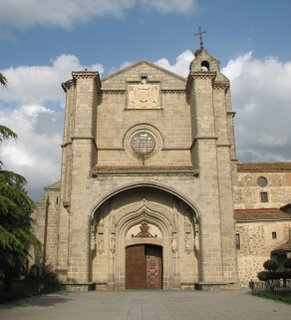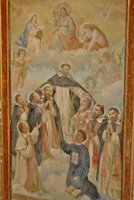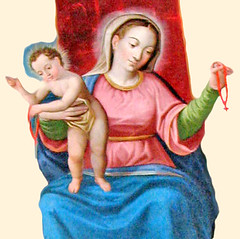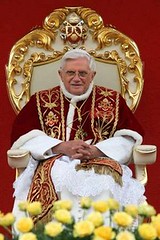Avila (Part Two)

 On 24 August 1562, not without difficulty, St Teresa of Avila founded the convent of Discalced Carmelite Nuns of the Primitive Rule of St. Joseph at Avila (shown on the right; and the plaque that commemorates it on the left). The site of her first reformed convent is outside the walls of Avila and across the city from the Encarnacion convent. She seems to have chosen St Joseph as her patron because earlier in her life, she had recovered from grave illness due to his intercession.
On 24 August 1562, not without difficulty, St Teresa of Avila founded the convent of Discalced Carmelite Nuns of the Primitive Rule of St. Joseph at Avila (shown on the right; and the plaque that commemorates it on the left). The site of her first reformed convent is outside the walls of Avila and across the city from the Encarnacion convent. She seems to have chosen St Joseph as her patron because earlier in her life, she had recovered from grave illness due to his intercession. Later in the evening we also visited St Teresa's own birthplace and family home which is now the Convent of La Santa. That site is very close to the walls, within the city of Avila, and is now surrounded by grand municipal buildings. From here it was a short walk to the church of San Juan where she was baptised and not much further down the hill to the Dominican Priory of Santo Tomas outside the walls. While in Avila, St Teresa would frequent this priory to see her Dominican confessor and she had a mystical experience in one of the side chapels here.
Later in the evening we also visited St Teresa's own birthplace and family home which is now the Convent of La Santa. That site is very close to the walls, within the city of Avila, and is now surrounded by grand municipal buildings. From here it was a short walk to the church of San Juan where she was baptised and not much further down the hill to the Dominican Priory of Santo Tomas outside the walls. While in Avila, St Teresa would frequent this priory to see her Dominican confessor and she had a mystical experience in one of the side chapels here.The Dominican Priory (below), dedicated to St Thomas Aquinas, was begun in 1483 as a royal foundation of the Catholic Monarchs, Ferdinand and Isabella and under the direction of the (in)famous Tomas de Torquemada, O.P. who was Isabella's confessor and later the first Grand Inquisitor of Spain. He later retired to this priory and was buried in the Sacristy. Also buried here is Don Juan, the beloved only son of the Catholic Monarchs.
 The convent is now under the care of friars of the mission-oriented Holy Rosary Province, who were wonderfully hospitable to us and who amazed us with their proficiency in English and regaled us with tales of their missions abroad. The friar who showed us around had been a missionary in the Philippines and taught at the University of Santo Tomas in Manila and knew some of the priests I worked with in Manila when they were student brothers! He was also keen to point out that Torquemada, our Dominican forebear, was terribly and unjustly maligned.
The convent is now under the care of friars of the mission-oriented Holy Rosary Province, who were wonderfully hospitable to us and who amazed us with their proficiency in English and regaled us with tales of their missions abroad. The friar who showed us around had been a missionary in the Philippines and taught at the University of Santo Tomas in Manila and knew some of the priests I worked with in Manila when they were student brothers! He was also keen to point out that Torquemada, our Dominican forebear, was terribly and unjustly maligned.The emblems of Ferdinand and Isabella (a yoke and a sheaf of arrows) is featured prominently on the church facade and cloisters and was also spotted above the central gateway of the city of Avila. In the beautiful and intricately-carved choir of the priory church are stalls for the Catholic monarchs. Below are photos from the priory and church:
 This is the Cloister of the Kings (above and below) which features the emblems of Ferdinand and Isabella very prominently, used as a repeating motif.
This is the Cloister of the Kings (above and below) which features the emblems of Ferdinand and Isabella very prominently, used as a repeating motif.

A second cloister (above) was the nucleus of a study house established by the Catholic Monarchs. As in the Cloister of the Kings, the arches on the second level maintain their Moorish shape and the lovely orb detailing. You'll need to click on the photos to view a larger-sized image.
 The interior of the church is most unusual. It seems that on account of the tomb of Don Juan which stands at the East end of the church (below), the High Altar (left) is raised on a gallery so that it stands at approximately the same height as the choir gallery in the West end. This arrangement is quite unlike any other I have seen before and quite practical... Raised to such a height, one can clearly see from the nave and choir loft what is happening at the altar!
The interior of the church is most unusual. It seems that on account of the tomb of Don Juan which stands at the East end of the church (below), the High Altar (left) is raised on a gallery so that it stands at approximately the same height as the choir gallery in the West end. This arrangement is quite unlike any other I have seen before and quite practical... Raised to such a height, one can clearly see from the nave and choir loft what is happening at the altar!


Here are the choir stalls which are in the raised choir gallery on the opposite end of the church from the raised High Altar. The stall in the photo on the left was reserved for Queen Isabella, who frequented the priory so as to pray at the tomb of her son and presumably to see her confessor when he had retired there.

That was our last stop for the day; we celebrated Mass at the Priory of Santo Tomas and then waited for our train back to Salamanca. Avila is an amazing city to visit simply on account of St Teresa of Jesus (above is her statue which stands at the gates of Avila) and her tremendous influence in Christian spirituality.
 But I was amazed to discover in this little city the presence of so many other great saints and personages too - St Vincent and his martyred sisters, St John of the Cross, Fra' Tomas de Torquemada, King Ferdinand and Queen Isabella and their son Juan (who until then were mere characters from my scant knowledge of Christopher Columbus) and the Dominican friars who were missionaries in Japan, Vietnam, the Philippines. Somehow, things had come full circle for me and this trip to Spain had put many things I saw and experienced in Manila in a larger context...
But I was amazed to discover in this little city the presence of so many other great saints and personages too - St Vincent and his martyred sisters, St John of the Cross, Fra' Tomas de Torquemada, King Ferdinand and Queen Isabella and their son Juan (who until then were mere characters from my scant knowledge of Christopher Columbus) and the Dominican friars who were missionaries in Japan, Vietnam, the Philippines. Somehow, things had come full circle for me and this trip to Spain had put many things I saw and experienced in Manila in a larger context...May St Teresa of Avila and the South-East Asian saints and beati of the Order of Preachers (pictured on the right) pray for us and for those who continue to work in the missions of the 'Far East'!







4 Comments:
Nice blog !
I will often return there!
In Christo
Dunstan
"not without difficulty" - now that is an understatement.
I do love your series on Avila, being that Teresa is one of my favorite saints.
thanks, Lawrence
Fr. Terry OP
Fr Terry,
A pleasure. I prayed for you and all at SLRP in Caleruega and in Avila.
Post a Comment
<< Home